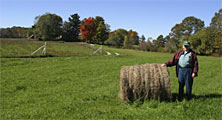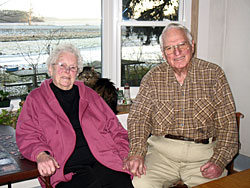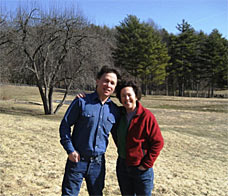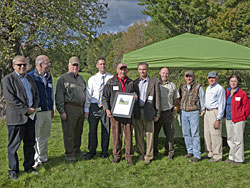The Langley Family: Protecting a Legacy of Place

photo by Eric Aldrich
Many landowners are seeking conservation solutions to protect their family lands. The Partnership offers conservation and financial options as an alternative to development, enabling families to pass their lands onto the next generation. The Langley family has owned and farmed their land on Durham Point since 1890. Known as the Little Bay Buffalo Company, the farm has a rich human history, beginning with Native Americans. In 2006, the Partnership purchased conservation easements on 87 acres with NOAA and municipal conservation funds, allowing the family to continue to own and manage the land for farming and forestry while safeguarding important habitat for a variety of birds and other wildlife. “Our family has always had a strong connection with the land,” David Langley said. “Our feeling is that we have a responsibility not just to the land itself, but also to our ancestors and the way the land provided for them. So we all felt the land here was worth protecting
The Smith Farm: Protecting for Future Generations

photo by Dea Brickner-Wood
In the summer of 1938, Gerry Smith was heading to a 4-H Camp in New Castle when he glimpsed from the car window a white farm house and a herd of Jersey cows grazing in a field along Great Bay. “I knew that someday I wanted to live there,” he recalls. Eventually Gerry would return to the historic “Onion Farm”, located along Route 4 where the Bellamy River meets the Great Bay. In 1955 Gerry and his wife Dottie purchased the Durham farm, settled down and raised their family. In 2007, Gerry and Dottie, along with two of their children, approached the Partnership about protecting the 70-acre farm. Through the sale of conservation easements, held by the Society for the Protection of New Hampshire Forests, the Smith family achieved their goal of permanently protecting the property’s productive farm and forest soils, wildlife and waterfowl habitats, and the stunning views of the water.
Many landowners, like the Smiths, are seeking conservation solutions to protect their family lands. The Partnership offers conservation and financial options as an alternative to development, enabling families to pass their lands onto the next generation.
Peter Popov & Lela Love: Making It Whole Again

photo by Popov/Love
Peter Popov recalls the childhood visits to his grandfather’s farm along Great Bay. In the 1970’s and 1980’s Peter and his wife, Lela Love, hadthe opportunity to purchase an additional abutting 91 acres of woodlands. “The more time we spent on the farm and in the woods, the more apparent it became to us how unique and special they are and how many species of wildlife (plants and animals) depend on them.” In 2007, working with the Partnership and The Nature Conservancy, Peter, his siblings and cousin sold a conservation easement permanently protecting the 79-acre farm that has been in the family since 1940. In 2009, Peter and Lela completed their long-term vision, and working once again with the Partnership, permanently protected their 91 acres of woodland through the sale of a conservation easement, held by the New Hampshire Fish and Game Department. “We also realized that if we did not take steps to protect this land, it was likely, sooner or later, to be disturbed and perhaps in catastrophic way. In simple terms, we concluded that it would have been reckless to leave such beautiful and peaceful land unprotected.”
The woodland parcel, located in the Crommet and Lubberland Creek watershed, includes an extensive network of beaver ponds, wetlands and habitat for the State Endangered Blanding’s turtle. It also supports an active great blue heron rookery. Hikers following the Sweet Trail, which winds its way through protected lands in to Great Bay, can view a nesting pair of herons and other wildlife. Peter and Lela offer another view of the land: “Human lives are relatively short (and unpredictable) compared to how long the land has existed. We believe that preserving such a beautiful and serene place is the best legacy we can leave.”
Many landowners, like Peter Popov and Lela Love, are seeking conservation solutions to protect their family lands. The Partnership offers conservation and financial options as an alternative to development, enabling families to realize their long term goals.
Celebrating the 100th Conservation Property at Great Bay ~ The Brett Farm
On a beautiful, blustery October day, community members, landowners and conservation partners gathered at the Brett Farm in Madbury, NH to celebrate the protection of an important property that also marked a conservation significant milestone – the completion of the 100th conservation property at Great Bay.
The Brett farm is a special place. Nick Brett led the family’s conservation effort to fulfill his father Wesley’s wishes to conserve the 53-acre property. Speaking at the celebration event, he recalled the family’s move in 1946 from an “in-town” location in Durham to the farm “in the country”. Growing up on the family farm fostered a connection to the land that has remained with Nick and his siblings. Motivated to keep the farm in the family, a conservation easement was sold to The Nature Conservancy, who made the purchase on behalf of the Partnership. The family trust will continue to own the land, and the conservation easement will be held by the New Hampshire Fish and Game Department.
Many landowners, like the Brett family, are seeking conservation solutions to protect their family lands. The Partnership offers conservation and financial options as an alternative to development, enabling families to realize their long term goals. The Brett property conservation easement provides permanent protection for important resources including 1,300 feet along Gerrish Brook, a tributary to the tidally-influenced Johnson Creek that connects to the Oyster River and Great Bay. This section of Gerrish Brook has been documented to include a State species of concern, the red fin pickerel, and a rare blue sedge. Ultimately preserving land like the Brett property, along with the other 99 properties around Great Bay, has an impact on the health of the natural systems that wildlife depend on, and people enjoy.
Photos top to bottom: copyright Eric Aldrich, copyright Dea Brickner-Wood, copyright Popov/Love
